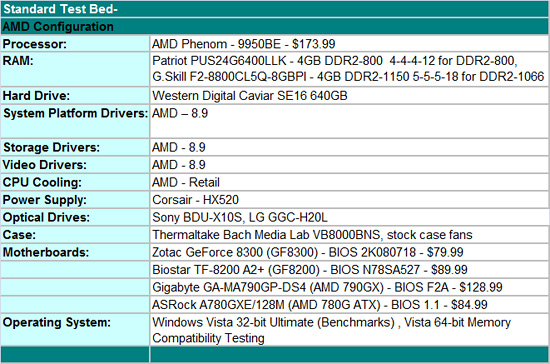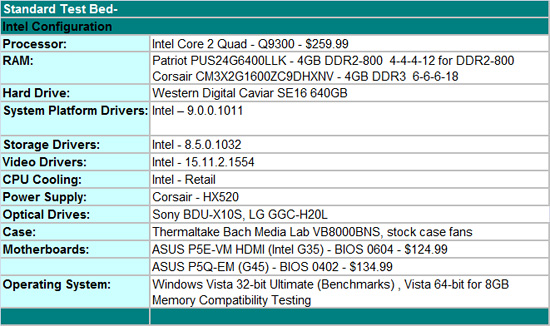The IGP Chronicles Part 2: AMD 780G vs. Intel G45 vs. NVIDIA GeForce 8200
by Gary Key on October 14, 2008 12:40 PM EST- Posted in
- Motherboards
AMD vs. Intel vs. NVIDIA: Fight
At the heart of AMD's 780G we have what AMD is calling a Radeon HD 3200 graphics core, providing the most powerful (on paper) integrated graphics on the market today. The table below should shed some light on the balance of power:
| AMD 790GX | AMD 780G | Intel G45 | Intel G35 | NVIDIA GeForce 8300 | NVIDIA GeForce 8200 | |
| Graphics | Radeon HD 3300 | Radeon HD 3200 | GMA X4500 |
GMA X3500 |
GeForce 8300 mGPU | GeForce 8200 mGPU |
| Core Clock | 700MHz | 500MHz | 800MHz | 667MHz | 500MHz Core / 1.5GHz Shader |
500MHz Core / 1.2GHz Shader |
| Shader Processors | 8 (5-way) | 8 (5-way) | 10 |
8 |
8 | 8 |
| Full H.264/VC-1/MPEG-2 HW Decode | Yes | Yes | Yes | No | Yes | Yes |
While Intel's G35, NVIDIA's GeForce 8200, and AMD's 780G all have 8 of what we're calling "SPs" or stream processors, their clock speeds and capabilities vary greatly from one to the next. Intel and NVIDIA are closest in this regard, as each SP has a peak throughput of a single instruction per clock. AMD's architecture is a bit more capable in the sense that each SP can have a maximum throughput of 5 instructions per clock. It gets a bit more complicated as NVIDIA has separate hardware for transcendental operations, which occupy one of the five "slots" in each AMD SP.
If you multiply it all out that gives Intel a throughput of 8 instructions per clock for G35, 10 for G45, 10 for NVIDIA's GeForce 8200 (where two are transcendental operations) and 40 for AMD. In terms of worst case throughput however, AMD falls down to 8 per clock (assuming the compiler can't feed the hardware 4 shader ops + 1 transcendental per SP) as does NVIDIA. This worst case rarely happens, but it is definitely worth noting.
Taking clock speeds into account, Intel really falls behind here. While G45 has a similar instruction throughput to NVIDIA's architecture, it runs its SPs at 800MHz while NVIDIA runs its at 1.4GHz giving NVIDIA a 75% raw performance advantage. AMD's core runs much slower at 500MHz, but the SPs are far more complex, so we end up with the following scenarios:
In the best case for AMD, the 780G is 43% more powerful than the GeForce 8200, but in the worst case NVIDIA's hardware is 1.8x faster than AMD's thanks to the clock speed advantage and AMD's dependency on ILP within an instruction stream. The integrated graphics race then becomes even more variable than how AMD/NVIDIA stack up with discrete GPUs; the swing from an AMD advantage to an NVIDIA advantage is much wilder than what we see with the GeForce GTX 260 vs. Radeon HD 4850.
The Test
Our Intel test bed today features the Q9300 quad-core processor and the AMD/NVIDIA platform features the Phenom X4 9950BE. Both of theses processor offers terrific performance with decent power consumption and thermals for the cost. Our Patriot DDR2-800 Viper 4GB memory kit has served us well for the past few months and we highly recommend it. We chose Corsair for our HX-520W power supply that has served us well in testing a variety of IGP solutions. Our favorite midrange HDD continues to be the Western Digital SE16 640GB that provides the near perfect balance of price, performance, and capacity.
Our motherboard selection represents a small cross section of IGP products based on the Intel G35/45, AMD 780G, and NVIDIA GeForce 8200/8300 products. While we tested over fourteen motherboards for this article, we're using the results from the best of the best for each chipset.












41 Comments
View All Comments
sergev - Monday, January 12, 2009 - link
A fair comparison? Don't think so! A AMD processor with a 140 Watt TDP and a Intel processor with a 95 Watt TDP?? I wonder why the intel chipsets seem more power efficient? If you are testing the performance, ok seems fair, but power efficiency should be measured with two processors with the same TDP. I am convinced that if you did the same test with a AMD 4850E the AMD would beat the crap out the intel versions on power consumption. But yet again, that would not be fair. So keep in mind that this review is not to be taken al to seriously!axiomhk - Tuesday, October 28, 2008 - link
Hi, what amazes me is that it seems no reviewers of the AMD IGP chipsets have caught the serious 2D issues referred to here:http://forums.amd.com/game/messageview.cfm?catid=2...">http://forums.amd.com/game/messageview....9&th...
However, the only channel that we consumers / mere mortals have to put pressure on AMD is to send feedback to the Catalyst team. Nothing seems to get done and there is not even any acknowledgement that this issue exists across the HD3200/HD3300 IGPs no matter which manufacturer.
The 3D performance is hyped up and that's all very well when the chipset has shown that it can deliver, but in fact many users will spend a lot of time on 2D activities which truly suck. This makes a lot of users regret their purchase.
What the renowned sites such as anandtech and tomshardware can do is try to reproduce the issues, then use their direct contacts to try to see if this issue is being addressed and update the parent article accordingly. Is it possible? Many thanks. GM - Hong Kong.
Zap - Wednesday, October 15, 2008 - link
"The keyboard is not available after drive recognition until the Windows startup routine"Try a different keyboard, or a PS/2 keyboard. I had the same problem with two MSI 750a boards and some Razer USB keyboards. No keyboard until Windows. I had to fix a BIOS problem and had to borrow a keyboard - Logitech G15 USB keyboard worked fine.
arjunp2085 - Wednesday, October 15, 2008 - link
Is this not a bit ODD to Compare a $260 to a Lowly Under performing [B}$173 CPU... Geezs This is Grossly inaccurateThink about the BOOST to Post Processing and It differs a Whole Lot to the Post processing capability
Strid - Wednesday, October 15, 2008 - link
Yeah, it would have made more sense, IMO, to use lower end processors like AMD 4850E or Intel E5200/7200 which is what most people would use in a HTPC.But if you want to do encoding on your HTPC also, I can see the need for a quad core. But not for your average "movie box".
Staples - Tuesday, October 14, 2008 - link
Really, this thing came out like 6 months ago it seems and finally we get some video benchmarks on anandtech. I know it has been commented that it did not work right for months because the video drivers were terrible but I can not believe it really took that long. When I had to get a HTPC, I just bought an Athlon BE and a 780G board. Much cheaper and adequate. Which in hindsight the P45 may have performed better, an Intel CPU and a Core 2 CPU would have driven the price up quite a bit.Kreed - Tuesday, October 14, 2008 - link
Gary, what are you hinting at with the following statement?"That leaves the Intel G45. If you are an Intel fan, this is your only real IGP choice... for the next few days at least."
Are you suggesting that Intel might be releasing a new IGP over the
Kreed - Tuesday, October 14, 2008 - link
Oops, i didn't get to finish the comment. Here's the comment in full:Gary, what are you hinting at with the following statement?
"That leaves the Intel G45. If you are an Intel fan, this is your only real IGP choice... for the next few days at least."
Are you suggesting that Intel might be releasing a new IGP over the next few days?
Strid - Wednesday, October 15, 2008 - link
The NVIDIA MCP7A (GeForce 9300/9400 IGP) boards supposedly launches today. They're sockey 775 boards. I'm pretty sure AnandTech will have a review up soon.http://www.silentpcreview.com/forums/viewtopic.php...">http://www.silentpcreview.com/forums/viewtopic.php...
GPGPUman - Tuesday, October 14, 2008 - link
AMD 780G and 790GX have 8 stream processors (5-way) for a total of 40 possible ops per clock... NOT 10